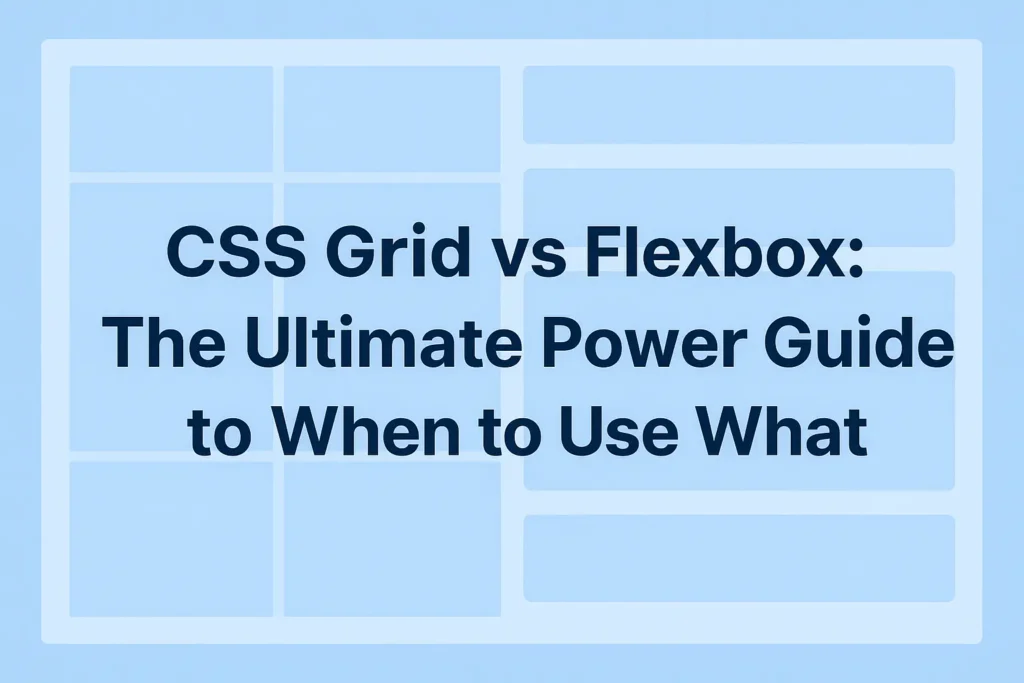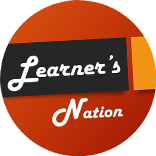CSS Grid vs Flexbox: The Ultimate Power Guide to When to Use What
If you’ve ever tried to build a website, you know how tricky it can be to get everything lined up just right. Remember the old days? We were using HTML tables and float properties just to cobble together a basic layout—it was honestly a bit of a mess. Luckily, CSS has evolved, and now we have two fantastic tools to solve these problems: CSS Grid and Flexbox. They both make it way easier to create clean, responsive designs that don’t take forever to code.
But that leaves us with a common question: when should you use Grid, and when is Flexbox the better choice?
Here’s the thing—they’re not really rivals. Each one has its own strengths. Flexbox might be the perfect solution for something smaller, like a navbar or a set of buttons, while Grid absolutely shines when you need to define an entire page structure with rows and columns. Understanding the difference isn’t just about memorizing code; it’s about working smarter. It saves you time, helps you avoid clunky workarounds, and lets you build layouts that are both professional and adaptable.
This guide will walk you through the real-world differences between CSS Grid and Flexbox, with clear examples of where each one excels. You’ll learn how to decide which tool to reach for and how they can even work together. By the end, you’ll have a much clearer sense of how to choose the right tool for your next project.

What is Flexbox?
Flexbox (Flexible Box Layout) is a CSS tool that helps arrange items in a row or a column. It’s great for simple, one-dimensional layouts like navbars, buttons, or centering elements. Instead of writing lots of CSS, Flexbox makes alignment and spacing easy with just a few properties.
Flexbox comes with a set of powerful features that solve many common layout problems developers face. Here are some of its highlights:
- One-Dimensional Layout → Flexbox works either in rows or in columns, but not both at the same time. This makes it perfect for simple, linear designs.
- Easy Alignment → With properties like
justify-contentandalign-items, you can center, space out, or align items with just a few lines of code. - Flexibility in Size → Child elements can automatically grow, shrink, or wrap to fit available space using
flex-grow,flex-shrink, andflex-wrap. - Order Control → You can easily change the order of elements on the page without touching the HTML, just by using the
orderproperty. - Responsive by Nature → Because items adjust themselves to available space, Flexbox is great for building layouts that adapt to different devices.
.container {
display: flex;
justify-content: space-between;
align-items: center;
}What is CSS Grid?
CSS Grid is a layout system in CSS made for two-dimensional layouts — it works with both rows and columns. It’s perfect for building page structures like headers, sidebars, content areas, and footers. Unlike Flexbox, Grid lets you place items exactly where you want them on the page.
CSS Grid comes with a powerful set of features that make complex layouts much easier. Here are some of its highlights:
- Two-Dimensional Layout → Grid works with both rows and columns, making it ideal for complex designs.
- Explicit Placement → With properties like
grid-template-rowsandgrid-template-columns, you can define exactly where elements should appear. - Grid Areas → You can name parts of the layout (like header, sidebar, footer) and arrange them with simple rules.
- Gap Control → The
gapproperty lets you add spacing between rows and columns without extra margins. - Overlapping Items → Elements can be layered in the same grid cell, which is hard to do with Flexbox.
- Responsive Layouts → Using
frunits,auto-fit, andminmax(), you can create layouts that adjust smoothly to different screen sizes.
Pros and Cons of Flexbox and CSS Grid
Pros and Cons of Flexbox
| Pros | Cons |
|---|---|
| Great for one-dimensional layouts (row OR column). | Cannot handle two-dimensional layouts (rows + columns). |
| Simple syntax, easy to learn. | Requires nesting for complex structures. |
| Excellent for aligning and spacing items with minimal code. | Limited control over entire page layouts. |
| Naturally responsive – items can grow, shrink, or wrap. | May need extra wrappers for advanced layouts. |
| Works in almost all browsers, including older ones. | Some advanced properties may behave differently across browsers. |
Pros and Cons of CSS Grid
| Pros | Cons |
|---|---|
| Perfect for two-dimensional layouts (rows + columns). | Can feel too complex for simple layouts. |
| Allows explicit placement of elements using grid lines. | Steeper learning curve for beginners. |
| Grid areas make layouts more semantic and easier to manage. | Sometimes requires more planning before coding. |
Built-in responsive features like fr, auto-fit, and minmax(). | Not fully supported in very old browsers (like IE11). |
| Reduces the need for extra containers or wrappers. | Can be overkill for small UI elements. |
CSS Grid vs Flexbox: When to Use What
When to Use Flexbox
Flexbox is most useful when you are working with one-dimensional layouts, meaning content arranged in either a row or a column. It excels at distributing space, aligning elements, and making items flexible so they automatically adjust to different screen sizes. This makes it perfect for navbars, menus, buttons, or forms where alignment and spacing matter more than creating a full page structure. In short, Flexbox is best when the focus is on arranging and aligning content in a single line.
- Navbar and Menus → Flexbox is great for arranging items in a single row or column, making it perfect for navigation bars, dropdown menus, and toolbars.
- Centering Elements → With properties like
justify-contentandalign-items, Flexbox makes centering items vertically and horizontally super easy. - Flexible Content Blocks → Ideal for cards, buttons, or lists that should adapt to different screen sizes while maintaining spacing and alignment.
When to Use CSS Grid
CSS Grid, on the other hand, is designed for two-dimensional layouts where both rows and columns need to be managed together. It provides precise control over where elements are placed, making it ideal for page-level designs such as headers, sidebars, main content, and footers. Grid is also a great choice for image galleries, portfolios, or complex dashboards where a structured and consistent layout is essential. In short, CSS Grid is best used when designing the overall structure of a page or section.
- Page-Level Layouts → Grid is built for structuring entire web pages with headers, sidebars, main content, and footers.
- Image Galleries and Portfolios → Grids make it simple to create evenly spaced galleries that adapt beautifully to different screen sizes.
- Complex Dashboards and Templates → For admin panels, analytics dashboards, or any interface with both rows and columns, Grid provides precision and control.
CSS Grid vs Flexbox: Developer Perspectives
Many developers get confused about whether to use CSS Grid or Flexbox. The truth is, they are not competing tools — they solve different layout problems. Understanding how they complement each other can make your design process faster, cleaner, and more efficient.
Complementary Tools, Not Competitors
Think of CSS Grid as the “big picture” tool and Flexbox as the “fine-tuning” tool. Grid is perfect for creating the overall structure of a page, like dividing it into rows and columns. On the other hand, Flexbox works best when you need to align or distribute items inside a section, such as buttons in a navbar or cards in a row. Instead of choosing one, developers usually mix both for the best results.
How Experts Use Both Together
Professional developers rarely stick to just one. For example, they may use Grid to create the full page layout (header, sidebar, main content, footer) and then use Flexbox inside the header to perfectly center a logo and navigation links. This combination makes layouts more flexible, responsive, and easier to maintain. The key is to use Grid where structure is needed and Flexbox where alignment and spacing matter.
Combining CSS Grid and Flexbox
Why You Should Mix Them
CSS Grid and Flexbox are not rivals but teammates. Grid gives you a strong two-dimensional structure (rows and columns), while Flexbox shines when controlling alignment and spacing inside a single row or column. By mixing them, you get the best of both worlds — Grid for the big picture layout and Flexbox for fine-tuned element positioning. This approach makes your code cleaner, easier to maintain, and highly responsive across devices.
Practical Example of Combined Use
Imagine building a website layout: you use CSS Grid to define the page structure with a header, sidebar, main content, and footer. Inside the header, you need a logo on the left and navigation links evenly spaced on the right. That’s where Flexbox comes in. You can apply Flexbox to the header content to align the logo and menu items neatly without writing extra CSS hacks.
In short:
- Use Grid for page-level or section-level structure.
- Use Flexbox for alignment and distribution inside those sections.
External Resources and Learning Guides
If you want to dive deeper into CSS Grid and Flexbox, here are some trusted resources that developers around the world rely on:
- MDN Web Docs: CSS Grid Layout – The official Mozilla guide with clear explanations and browser compatibility notes.
- MDN Web Docs: CSS Flexible Box Layout – Detailed documentation of Flexbox with examples and properties.
- CSS-Tricks: A Complete Guide to Grid – A very popular developer-friendly cheat sheet with visuals.
- CSS-Tricks: A Complete Guide to Flexbox – One of the most shared guides, great for beginners and pros.
- Grid by Example – A dedicated site by Rachel Andrew (co-editor of the CSS Grid spec) with practical Grid examples.
- Flexbox Froggy – An interactive game to learn Flexbox while having fun.



